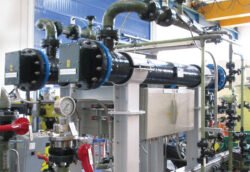Peroxide Injection Units
Peroxide Injection Units: A Comprehensive Overview
Introduction
Peroxide Injection Units (PIUs) play a crucial role in various industrial processes, particularly within the oil and gas sector. These units are integral in enhancing oil recovery, managing sulfide levels, and ensuring the safety and efficiency of operations. This article offers an in-depth look into the fundamental aspects of PIUs, their applications, technological advancements, and future trends.
What are Peroxide Injection Units?
Peroxide Injection Units are specialized systems designed to inject hydrogen peroxide (H₂O₂) into industrial processes. Due to its strong oxidizing properties, hydrogen peroxide is often used to achieve specific chemical reactions. PIUs are engineered to precision, allowing for controlled injection rates, pressure settings, and concentrations tailored to different industrial requirements.
Components of Peroxide Injection Units
PIUs are composed of several key components, each essential for their operation:
-
- Storage Tanks: These are used to store hydrogen peroxide safely. Given that hydrogen peroxide is reactive and decomposes over time, these tanks must be constructed from materials that are resistant to oxidization.
-
- Pumps: High-precision pumps are employed to maintain accurate flow rates and pressures, ensuring effective and safe peroxide injection.
-
- Control Systems: These electronic systems enable operators to monitor and adjust the injection process. Modern units often feature digital interfaces with automated feedback loops for optimal performance.
-
- Injection Nozzles: They determine the dispersion pattern and efficiency of chemical reactions induced by the peroxide.
-
- Safety Sensors: Given the reactive nature of hydrogen peroxide, PIUs include safety sensors to detect leaks or overpressure situations, thus preventing accidents.
Applications of Peroxide Injection Units
PIUs have diverse applications across multiple industries:
1. Oil and Gas
One of the most significant applications of PIUs is in the oil and gas sector, particularly in Enhanced Oil Recovery (EOR). Hydrogen peroxide is used to increase the permeability of oil reservoirs, thereby facilitating more efficient extraction of trapped oil. Moreover, PIUs help in oxidizing hydrogen sulfide, a common by-product in oil wells, thus reducing corrosion and maintaining safety.
2. Water Treatment
In water treatment, PIUs are used for advanced oxidation processes (AOPs). The strong oxidizing power of hydrogen peroxide breaks down organic contaminants, disinfects water, and aids in odor control. This process is crucial for municipal water supplies and wastewater treatments.
3. Industrial Manufacturing
PIUs find application in the manufacturing of textiles, paper, and chemicals. In pulp and paper industries, hydrogen peroxide is used for bleaching purposes. Similarly, in textile manufacturing, it’s used for bleaching and dyeing, ensuring vibrant colors and high-quality finishes.
4. Environmental Remediation
Environmental cleanup projects employ PIUs for soil and groundwater remediation. The oxidative properties of hydrogen peroxide help break down pollutants and contaminants, rendering these environments safer and more conducive to ecological recovery.
Technological Advancements in Peroxide Injection Units
Recent years have seen significant technological advancements in PIUs, making them more efficient and safer:
1. Automation and Control
Advancements in automation have transformed PIUs, allowing for more precise control over injection processes. Sensors and digital interfaces enable real-time monitoring and adjustments, reducing the risk of human error.
2. Energy Efficiency
Modern PIUs are designed to minimize energy consumption, using energy-efficient pumps and motors. This not only reduces operational costs but also aligns with the growing demand for sustainable industrial practices.
3. Improved Materials
Developments in materials science have led to the use of corrosion-resistant materials in the construction of PIUs. This enhances their durability and reduces maintenance requirements, thus optimizing long-term performance.
4. Integration with IoT
The integration of Internet of Things (IoT) technologies has allowed PIUs to be connected to larger industrial control systems. This connectivity facilitates predictive maintenance, timely troubleshooting, and comprehensive data analysis, enhancing overall efficiency and reliability.
Challenges and Considerations
While PIUs offer numerous benefits, there are challenges and considerations that must be addressed:
Handling and Safety
The reactive nature of hydrogen peroxide requires stringent safety measures during handling and storage. Improper handling can lead to dangerous decompositions, releasing oxygen and heat.
Environmental Impact
Though beneficial in pollutant breakdown, the use of large volumes of hydrogen peroxide must be managed to prevent unintended ecological consequences. Ensuring proper dosage and containment is vital to safeguarding ecosystems.
Cost
The initial cost of setting up PIUs can be significant, especially for smaller operations. However, advancements in technology and economies of scale are gradually reducing these costs.
Future Trends in Peroxide Injection Units
The future of PIUs looks promising, with several trends shaping their development:
Sustainability Focus
As industries strive for sustainability, the role of PIUs in reducing waste and optimizing resource use will become increasingly important. Research into biodegradable materials and sustainable catalysts may lead to more environmentally friendly peroxide injection methods.
Advanced Data Analytics
The integration of advanced data analytics and machine learning will enable more accurate predictions of PIU performance and potential issues. This proactive approach will minimize downtime and enhance operational efficiency.
Global Expansion
With the rising global demand for oil, clean water, and sustainable industrial practices, the need for PIUs is set to expand. Emerging markets may drive demand, necessitating the adaptation of PIUs to different environmental and regulatory conditions.
Collaborative Innovations
Research collaborations between academic institutions, industry leaders, and technology developers are likely to spur further innovations in PIU technology. These partnerships can lead to breakthroughs in efficiency, safety, and environmental impact minimization.
Conclusion
Peroxide Injection Units are a vital component of modern industrial processes across diverse sectors. Their ability to enhance efficiency, safety, and environmental compliance is unmatched. As technology continues to evolve, PIUs are set to play an even more critical role in meeting the needs of an increasingly resource-conscious and sustainability-focused world. Through ongoing research, development, and innovation, PIUs will undoubtedly continue to drive progress in industrial chemical processes, providing valuable solutions to both current and future challenges.

